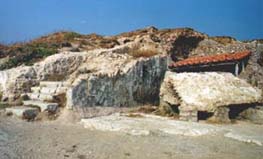|
Sorrento was
probably founded by Greeks. Like many cities of southern Italy it
had close contacts with the Mycenaen civilization from which it
derived the myth of Sirens. It fell under the domain of the
Greeks of Syracusa in the year 474 B.C., and then it was
subsequently subjected to the Samniti and then to the Romans.
Under the Roman Empire it became a post much sought after by the
wealthy who had luxurious villas built there.
 After a long period
of Byzantine administration, and when this started to decline, it
became a free Dukedom (start of the IXth century) with boundaries
that went from Punta Campanella (ends of the Sorrentine Penisula
in Massalubrense) to Stabia. In the XIIth century it was
conquered by Ruggiero the Norman and in the following centuries
it became feud of Gabriele Correaale and Giovanna D'Aragona. After a long period
of Byzantine administration, and when this started to decline, it
became a free Dukedom (start of the IXth century) with boundaries
that went from Punta Campanella (ends of the Sorrentine Penisula
in Massalubrense) to Stabia. In the XIIth century it was
conquered by Ruggiero the Norman and in the following centuries
it became feud of Gabriele Correaale and Giovanna D'Aragona.
It went through one
of the most crutial crisis for the attempts of rebellion against
the Spanish domain, for the local conflicts with the near Vico
Equense, for a serious of epidemics and for the terrible Turkish
invasion in 1588.
 Although in such
unsteadiness, between the end and the whole space of the 1600s,
Sorrento renewed its urban tissue also for the presence in the
city of many religious orders. In the XVIIIth century the policy
of distension and reformism of Charel of Bourbon allowed a
general resumption of the economic life and the revival of
agricultural and mercantile activities. Country home of Torquato
Tasso, between the XVIII and the XIX cen.) it became destination
of the greatest intellectuals of the time. Although in such
unsteadiness, between the end and the whole space of the 1600s,
Sorrento renewed its urban tissue also for the presence in the
city of many religious orders. In the XVIIIth century the policy
of distension and reformism of Charel of Bourbon allowed a
general resumption of the economic life and the revival of
agricultural and mercantile activities. Country home of Torquato
Tasso, between the XVIII and the XIX cen.) it became destination
of the greatest intellectuals of the time.
Sorrento, for its
natural beauties and for its links with the classical myths, has
always fascinated visitors, inspiring painters and engravers that
for years depicted typical costline spots.
|
